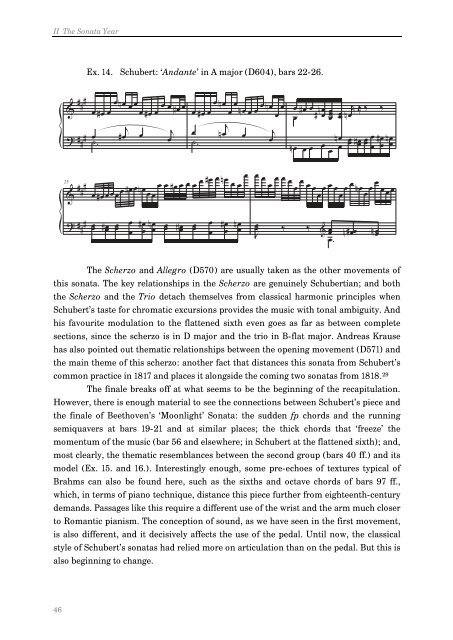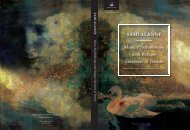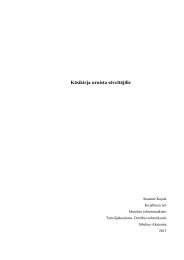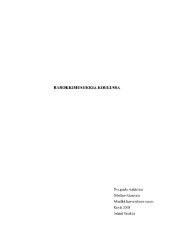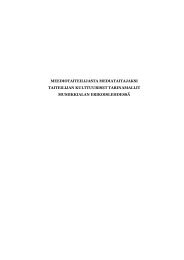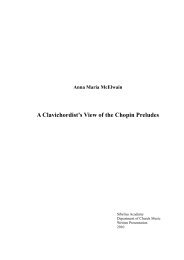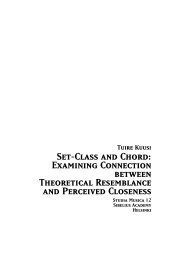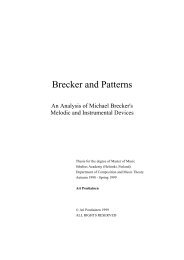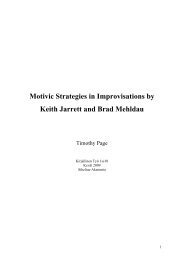The Unfinished Piano Sonatas of Franz Schubert Javier ... - Ethesis
The Unfinished Piano Sonatas of Franz Schubert Javier ... - Ethesis
The Unfinished Piano Sonatas of Franz Schubert Javier ... - Ethesis
You also want an ePaper? Increase the reach of your titles
YUMPU automatically turns print PDFs into web optimized ePapers that Google loves.
II <strong>The</strong> Sonata Year<br />
Ex. 14. <strong>Schubert</strong>: ‘Andante’ in A major (D604), bars 22-26.<br />
#<br />
& #<br />
#<br />
œ # œ œ<br />
? # #<br />
#<br />
œ n œ œ œ œ # œ œ œ œ # œ œ<br />
œ # œ œ<br />
j<br />
œ<br />
# œ œ j<br />
˙ .<br />
œ<br />
œ n œ œ<br />
œ n œ œ œ œ n œ œ œ<br />
œ œ<br />
œ<br />
j<br />
n œ œ j<br />
˙ .<br />
œ<br />
œ # œ n œ r ≈ ‰ ‰<br />
# œ œ œ n œ<br />
n œ<br />
n œ œ œ œ<br />
œ œ œ œ # œ œ œ œ # œ n<br />
#<br />
& #<br />
#<br />
25<br />
? # #<br />
#<br />
œ # œ œ œ œ œ # œ œ n œ œ œ œ œ # œ œ œ œ œ # œ œ n œ œ œ œ<br />
œ œ # œ<br />
œ<br />
œ<br />
# œ n œ<br />
œ œ œ œ # œ<br />
œ<br />
œ<br />
# œ n œ<br />
œ œ<br />
œ œ œ œ<br />
œ œ œ<br />
œ œ œ œ œ œ œ<br />
œ œ œ n œ<br />
œ<br />
œ œ œ œ œ<br />
œ ‰ ‰<br />
J<br />
œ .<br />
&<br />
n # œœ<br />
œ n<br />
<strong>The</strong> Scherzo and Allegro (D570) are usually taken as the other movements <strong>of</strong><br />
this sonata. <strong>The</strong> key relationships in the Scherzo are genuinely <strong>Schubert</strong>ian; and both<br />
the Scherzo and the Trio detach themselves from classical harmonic principles when<br />
<strong>Schubert</strong>’s taste for chromatic excursions provides the music with tonal ambiguity. And<br />
his favourite modulation to the flattened sixth even goes as far as between complete<br />
sections, since the scherzo is in D major and the trio in B-flat major. Andreas Krause<br />
has also pointed out thematic relationships between the opening movement (D571) and<br />
the main theme <strong>of</strong> this scherzo: another fact that distances this sonata from <strong>Schubert</strong>’s<br />
common practice in 1817 and places it alongside the coming two sonatas from 1818. 29<br />
<strong>The</strong> finale breaks <strong>of</strong>f at what seems to be the beginning <strong>of</strong> the recapitulation.<br />
However, there is enough material to see the connections between <strong>Schubert</strong>’s piece and<br />
the finale <strong>of</strong> Beethoven’s ‘Moonlight’ Sonata: the sudden fp chords and the running<br />
semiquavers at bars 19-21 and at similar places; the thick chords that ‘freeze’ the<br />
momentum <strong>of</strong> the music (bar 56 and elsewhere; in <strong>Schubert</strong> at the flattened sixth); and,<br />
most clearly, the thematic resemblances between the second group (bars 40 ff.) and its<br />
model (Ex. 15. and 16.). Interestingly enough, some pre-echoes <strong>of</strong> textures typical <strong>of</strong><br />
Brahms can also be found here, such as the sixths and octave chords <strong>of</strong> bars 97 ff.,<br />
which, in terms <strong>of</strong> piano technique, distance this piece further from eighteenth-century<br />
demands. Passages like this require a different use <strong>of</strong> the wrist and the arm much closer<br />
to Romantic pianism. <strong>The</strong> conception <strong>of</strong> sound, as we have seen in the first movement,<br />
is also different, and it decisively affects the use <strong>of</strong> the pedal. Until now, the classical<br />
style <strong>of</strong> <strong>Schubert</strong>’s sonatas had relied more on articulation than on the pedal. But this is<br />
also beginning to change.<br />
46


